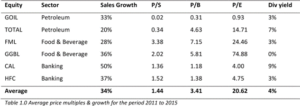We have all had the experience of seeing a maneuver in a movie, reading about an ingenious method in a book, or seemingly easy way of doing a difficult task on youtube. The caveat has always been “be careful when
trying this at home”. I remember first reading about the value and growth equity investment strategies and thinking how well thought-out the two strategies were and my resolve to implement them with stocks listed on the Ghana Stock Exchange (GSE). What I didn’t realize was the difficulty in implementing such a strategy for a less developed and less liquid stock market like the GSE.
 In identifying the difficulty, I decided to examine the two most popular equity investment strategies of growth and value and try to ascertain why it is difficult to implement them in Ghana. In furtherance to that, I considered a strategy that can work for the Ghanaian market and finally explored an alternative strategy that will work. The two strategies are so popular that there is an enormous body of research and indexes that have been constructed to track their performance.
In identifying the difficulty, I decided to examine the two most popular equity investment strategies of growth and value and try to ascertain why it is difficult to implement them in Ghana. In furtherance to that, I considered a strategy that can work for the Ghanaian market and finally explored an alternative strategy that will work. The two strategies are so popular that there is an enormous body of research and indexes that have been constructed to track their performance.
By definition, value investing is to buy stocks that are relatively cheap in terms of the price of its earnings or assets than about the company’s growth prospects. Value stocks have been found to have low price multiples. The low price multiples are price-to-earnings (P/E) ratio, price-to- book (P/B), price-to-sales (P/S) and high dividend yield (opposite of the rarely used price-to-dividend ratio). Value investors are of the view that these low multiples have a tendency to increase, because they are likely, as a result of recent earnings problems.
The value investor wins when stocks experience a positive movement in earnings to its historical levels. Value stocks have been known to pay dividends that are relatively high and can be found in the utilities and financial sectors. The main risk facing a value investor is their inability to understand why a stock is cheap in the first place. A stock can be cheap for very good economic reasons which might not change within the investor’s investment time horizon. It will be very easy and straight forward to select value stocks by identifying equities with low multiples but it is a totally different ball game when the rubber hits the road.
On the other hand, growth stocks have the opposite characteristics of value stocks in that growth investors are more concerned with future growth in earnings than they are with the price the stock is selling and are willing to pay top dollar (top cedi, in this case) for stocks that have superior growth potential. Growth stocks normally have high P/E, P/B and P/S ratios and pay very little dividend because they retain their earnings to fund future growth. The main risk here is the fact that the expected higher growth does not happen as expected. Stocks that exhibit superior growth potential in revenue are mostly found in technology, healthcare and consumer products sectors.
Studies done on both strategies have proven that they do work but it will be difficult to say that when using stocks listed on the GSE. Implementing a value or growth investment strategy in Ghana will be very difficult because of the challenge in classifying stocks as either growth or value, the low liquidity of our market and the lack of responsiveness of stock prices to fundamental changes in the companies.
The first problem any individual trying to implement a growth or value strategy is identifying stocks that fit the value or growth mold. Identifying a stock as either value or growth is a challenge because listed stocks on the GSE display mixed characteristics at any particular time. They may behave as growth stocks at a point and display characteristics of value stocks at another time or have a blend of the two strategies. To understand the complication, there is a selection of equities listed on the Ghana stock exchange and their average price multiples and growth rates over a period of five years from 2010 to 2015.

From the above table, I shall be considering two stocks that appear to fit the growth and value criteria: GOIL and CAL. GOIL is Petroleum stock that operates in the downstream sector as an oil marketing company whilst CAL is a universal bank. GOIL has low P/S, P/B and P/E ratios and therefore can be classified as a value stock. However it pays low dividend compared to the others and so can be inferred that it retains most of its earnings, which characterizes growth stocks.
A five year average growth of 33% is fairly high, a characteristic of a growth stock. CAL on the other hand has a lot of qualities that fit a growth stock: high P/S, P/B and P/E and a strong growth of an average of 50% over the five year period compared to GOIL. CAL however has the highest dividend yield among all the equities listed on the table (a value characteristic). The two stocks have a mixture of attributes which might qualify them as either value or growth stock and as more attributes of the stocks are assessed, the dividing line between growth and value becomes so blurred that classifying these equities become more subjective thus making the activity prone to errors.
The reader can pick one stock from the table and try to classify it as either a value or growth stock and see how easy or difficult it is. The problem is compounded the more by the “P” that appears in all the price multiples used to classify the stocks which leads to the second problem associated with following a growth or value strategy and for that matter any equity investment strategy in Ghana.
Prices of stocks listed on the Ghana Stock Exchange are not responsive to changes in either the fundamentals of the company or the economy. Which means that prices are stale and can therefore not be trusted to move in the direction that these strategies expect. A value investor expects the low price multiples to revert to their historical mean for the strategy to generate returns. A growth investor expects the superior growth to command premium prices in the stock thus providing an upward momentum in prices. Since prices do not respond to changes in company fundamentals, an investor who succeeds in correctly selecting either growth or value stocks will have to wait for a long time and hope that prices respond to the underlying changes in fundamentals and in the direction they expect the prices to go.
Liquidity on the GSE also provides a very significant barrier to implement any investment strategy because getting in and out of an equity is so difficult that you might be caught holding the wrong equities at the wrong time or not being able to buy the right equities at the right time. In any case the lack of liquidity will bit you in the face when you try to go for a growth or value strategy.
A relatively easier strategy to implement in Ghana is one that does not force the investor into either using a growth or value strategy but compromises between the two: market-oriented strategy. The market oriented investor buys stocks by not considering whether they are growth or value classified provided the stock is trading at a discount to its intrinsic value (the theoretically true value of the stock) and has prospects for future profitability. To implement the strategy an investor will have to use one or more of the stock valuation methods to estimate the stocks intrinsic value– an activity that is relatively easy compared to accurately classifying stocks as either value or growth.
Using a market oriented approach will not solve all the problems associated with investing in listed equities on the GSE but it will at least make it easy for some selected stocks based on how cheap they are compared to their estimated intrinsic value and then we can leave the growth and value investing to investors in markets that are more developed than ours.








